Commentary 15 Jan 2013 06:30 am
Oscaaars & Tyers
- I’m not sure if this is a complaint. It’s been tossing on my mind all week, and it’s good to get it out.
 The Oscars!
The Oscars!
I know, what now? you’re saying.
Well, there’s been a big change in the Oscar voting and it affects the animated short and who will become the winner. To understand the whole thing, let me give you a little history.
Back in the fifties – up to the very late fifties – the animated short (and, as it turns out, the live action short) were voted on by members who never saw the film. Say you work for WB in the costume department. The nominees for animated short are listed, and one is for Disney (naturally), one is for Terrytoons (20th Fox) and one is for WB. You haven’t seen the films, who do you vote for.
Naturally, you work for WB and WB has told you to vote for our own company.
So you vote for Knighty Knight Bugs.
Paul Bunyan and Sidney’s Family Tree lose your vote. Guess which one won?
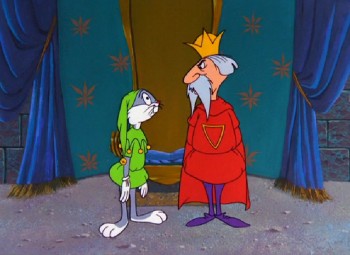
Knighty Knight Bugs
The same thing happened the year before – 1957 when a WB, Tweety cartoon won over a Droopy, a UPA and a Disney.
1956 they were all UPA cartoons, so a UPA cartoon won (Mr. Magoo, naturally.)
1955 a WB Speedy Gonzalez short beat out Disney, MGM and a Walter Lantz (Tex Avery) short.
So in 1959 a bunch of animation Oscar members sought to change things. All they asked was that the people who voted on the short subjects have to SEE the short subject. And what do you know, they changed the rule. If you wanted to vote for animated and live action short subjects, you had to see and prove you saw the short films.
Suddenly, things changed.
The nominees included a WB short, Mexicali Shmoes (Speedy Gonzales), a Disney short, Noah’s Ark and
2 Independent shorts were nominated:
John & Faith Hubley, Moonbird and
Ernie Pintoff, The Violinist
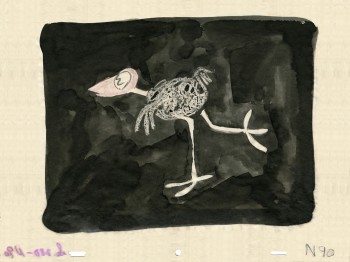
Moonbird
This time the WB short did not win, the Independent film did. Moonbird won the Oscar for the 1959 animated short.
Let’s get back to NOW.
This year, they are showing the shorts – all of them – in a screening. We can go, see 5 animated and 5 live action shorts and vote for them.
Or there’s another choice.
They’re sending out DVDs to ALL OF THE MEMBERS. The person working in the costume department will get a DVD with your short on it. (S)he might watch that DVD and vote for the film (s)he thinks deserves it. OR she might not put the DVD in the machine and vote for the film she heard of.
What! There’s a Maggie Simpson short in there. Aha. I like the Simpsons. Give it to them.
Oh wait! There’s a Pixar short in there. They do good work. And I think I saw an ad they took out in Variety. I’ll give it to the “Arty” Pixar film.
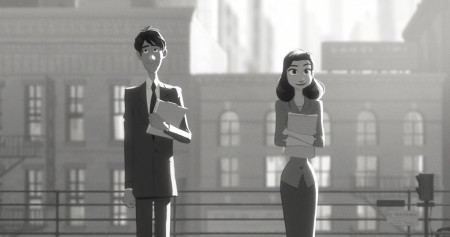
Paperman
Hmmm.
So I expect the “Arty” Pixar film to win or else the TV cartoon – the Simpsons. They’ll win.
The more things change, the more they stay the same.
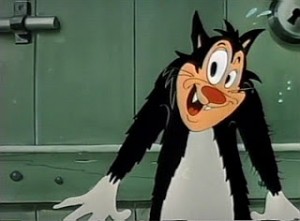 - Jim Tyer never won an Oscar. Actually he was never nominated for one. Too bad. He was a man before his time. His art was in distortion of the character trying to get to the emotional center of that character. At the same time, his drawings made you smile. It’s unfortunate that most people didn’t get it. The people of the period within which he worked. Younger generations today stop frame Jim Tyer‘s work and study it. They want to do it, themselves. But it’s a vain attempt if they do try. His
- Jim Tyer never won an Oscar. Actually he was never nominated for one. Too bad. He was a man before his time. His art was in distortion of the character trying to get to the emotional center of that character. At the same time, his drawings made you smile. It’s unfortunate that most people didn’t get it. The people of the period within which he worked. Younger generations today stop frame Jim Tyer‘s work and study it. They want to do it, themselves. But it’s a vain attempt if they do try. His 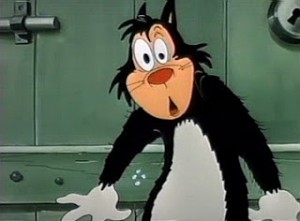 guy was a one-of-a-kind, and no one else could really do the same thing.
guy was a one-of-a-kind, and no one else could really do the same thing.
You can find in LA, at Bob Clampett‘s unit at WB, someone who tried for something similar. Rod Scribner was deeply affected by the comic strip work of George Lichty in his daily panel, “Grin and Bear It.” The distortion was too exciting for Scribner not to try pulling into his animation. He got permission from Clampett, and they did this wild style. It didn’t quite turn into the
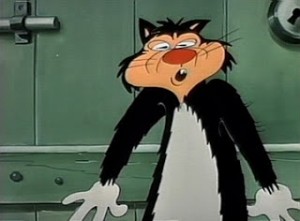 abstractions of Tyer, but it did its own thing. Scribner followed the animation rules too closely to be able to get what Tyer did. Scribner knew that if you distort a character you have to keep the same mass in the body of the character, and he did just that. If the eyes got wildly large, the rest of the body diminished to make up for it. If an arm withered, something in the body took on that mass. It kept the 3D masses to remain true.
abstractions of Tyer, but it did its own thing. Scribner followed the animation rules too closely to be able to get what Tyer did. Scribner knew that if you distort a character you have to keep the same mass in the body of the character, and he did just that. If the eyes got wildly large, the rest of the body diminished to make up for it. If an arm withered, something in the body took on that mass. It kept the 3D masses to remain true.
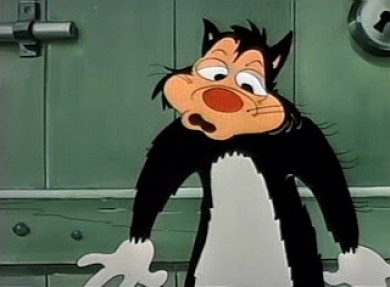 Tyer’s work was completely graphic. The body became an abstraction and the timing was wildly geared to Tyer’s own version of a “take” or “anticipation.” Even something like a “sneak” became a graphic excuse for his his own abstract movements.
Tyer’s work was completely graphic. The body became an abstraction and the timing was wildly geared to Tyer’s own version of a “take” or “anticipation.” Even something like a “sneak” became a graphic excuse for his his own abstract movements.
Tyer gave up 3-dimensional drawing and allowed the line to take control. He gave the forces in the animation full strength, but allowed the rules of animation to stay in place. Essentially it’s not a new language just a new
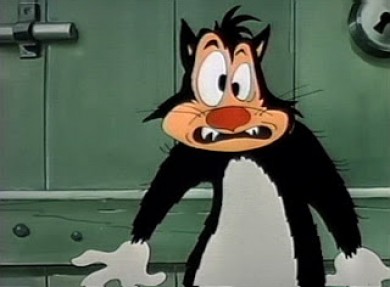 dialect. A very thick one, but new – just the same. It’s to animation what Creole is to English. Of course, the saving grace is that it couldn’t be funnier. The other animators weren’t crazy about the work Tyer was doing, but they didn’t know how to stop him. They just assumed he had permission to speak Creole.
dialect. A very thick one, but new – just the same. It’s to animation what Creole is to English. Of course, the saving grace is that it couldn’t be funnier. The other animators weren’t crazy about the work Tyer was doing, but they didn’t know how to stop him. They just assumed he had permission to speak Creole.
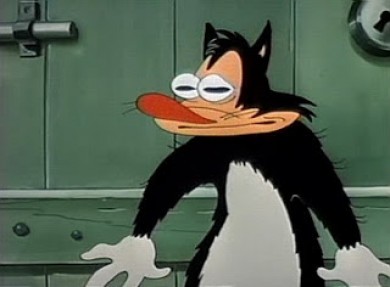
Many thanks to Kevin Langley who posted these images back in 2008.
He has the best frame grabs on the web, at least the most enjoyable.
There are many more frame grabs of the Jim Tyer material at Kevin’s site. Check out here, or here or keep browsing. It’s a treat of a site.
.
.
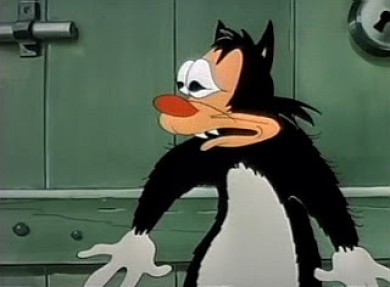
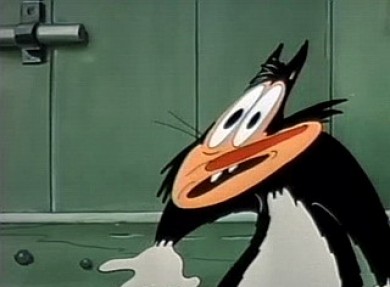
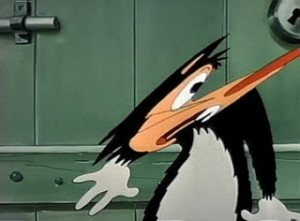
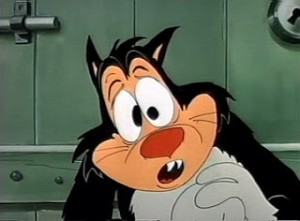

on 15 Jan 2013 at 12:11 pm 1.joel brinkerhoff said …
Jim Tyers’ work stands out like a sore thumb and you know what a sort thumbs stands out like. I find his style a variation of the ‘smear’ were a nose starts first in a direction and everything else is pulled by it.
on 15 Jan 2013 at 12:57 pm 2.joel brinkerhoff said …
Gene Deitch used Jim on Tom Terrific and other works tailored to his style. Tyers’ comic book work shows he was a good draftsman but an eccentric animator.
on 15 Jan 2013 at 1:08 pm 3.James Nethery said …
Just a note… PAPERMAN is actually Disney, not Pixar. Kind of unusual to not have a Pixar short up there, eh?
But yes, I expect PAPERMAN will get the Oscar this year. Well deserved in my opinion though I’d prefer to see the more indy shorts get the Oscar.
on 15 Jan 2013 at 1:55 pm 4.John said …
It’s interesting looking at Tyer’s work at Famous/Paramount, when he was head animator and had control of how the scenes were assigned and how they were animated, especially with Izzy Sparber or Dan Gordon as head animator. Tyer would normally assign himself the biggest action scenes, but he did adjust his animation to fit the scene, so that, say, Popeye and Bluto beating the hell out of each other in “Shape Ahoy” is different wildness than the same two doing Averyesque sexual reactions to Latina Olive in “W’ere On Our Way to Rio” (Tyer’s takes would get wilder in the Terrytoons years, but in some cases, the directors didn’t give him the scenes where his style of animation would be used to its best effect).
Many people have commented over the years that the ’58 Oscars gave the nod to a pretty run-of-the mill Bugs short, and not even the rabbit’s best cartoon of 1958 (or as funny as Friz Freleng’s nominated cartoon the following year). But given the fact Bugs’ best cartoons in the past had been shafted by Academy voters (mainly by the employees of MGM in the 1940s) and it was the character’s lone Academy win, it’s hard in hindsight to be really outraged about that particular pick, or the actions taken by Warners’ voters. But it can be annoying when you see people in any Oscar category voting on name recognition alone.
on 15 Jan 2013 at 3:41 pm 5.Michael said …
Joel, Tyer’s style doesn’t even remotely resemble the smear technique to me. The smear happens only in what might be out-of-focus frames. Tyer’s abstractions start the scene and continue right to the end of the scene. It’s the way they are drawn.
on 15 Jan 2013 at 7:08 pm 6.the Gee said …
He can speak for himself but on the link in his name there’s examples of Tyer scenes.
I know the definition of a “smear†can be pretty narrow but what you are describing is The Lichty, isn’t it? That is a full body/object smear (so to speak) that stretches the image*. Like you point out with the “out-of-focus frames†it is just one way to graphically represent camera or motion blurs.
I think Joel is just stating that he smeared parts while maintaining the form and maybe the rest of the pose.
That said, it is tough to think that for his entire technique Tyer only did smears because not every distortion is a smear and they certainly aren’t Lichtys’ stretched cobweb designs*.
*i guess it predates the distortion of an image on stretched Silly Putty and could be described as that or like a cobweb being pulled apart.
on 15 Jan 2013 at 8:12 pm 7.joel brinkerhoff said …
You’re right Michael, Tyer didn’t use a smear as normally thought of but his was variation on the technique used to bridge large distances in fast moving objects or appendages. The smear was used to simulate the blurring found in live action motion pictures caused by fast movement and slow film speeds. Tyer used it in almost a reversed fashion where a part of the body, say a nose, would stretch out in a direction before anything else. Then the rest would stretch to catch up with it. Tyer also had the habit of doing ‘shrink takes’ where the character would actually shrink in size and then pop back out again. He also blinked the pupil of an eye without blinking the lids over the eyeball, very strange stuff.
Have you noticed when one of Tyers characters zip out of frame his speed lines usually leave little ‘stick debris’, for lack of a better description, that tumbles around before disappearing?
on 15 Jan 2013 at 10:28 pm 8.the Gee said …
“It’s unfortunate that most people didn’t get it. The people of the period within which he worked. Younger generations today stop frame Jim Tyer’s work and study it. They want to do it, themselves. But it’s a vain attempt if they do try. His guy was a one-of-a-kind, and no one else could really do the same thing.â€
 very strange stuff.
It is still positive that he was inventive, isn’t it?
Maybe he was playing off of his weaknesses. Maybe he was demonstrating a strength. The end result is great to see and it should at least prove that there isn’t only one way to make that kind of funny animation.
I guess it is obvious there isn’t one way but hopefully it is one more example of how a character animator can make some great stuff by adding idiosyncratic— and almost completely abstract—touches.
From a problem solving standpoint, right on! From a creative standoint, sometimes you can make your own tools.
on 16 Jan 2013 at 11:39 am 9.Michael said …
I certainly agree with you there, Joel. Tyer was a one of a kind who saw animation as an art form; only he didn’t know it was art. But it sure as hell was. He really can’t be duplicated. John K has made a style out of what he’s found in Tyer, and he hasn’t scratched the surface yet. But I give him an A+ for making his own breed of lemons.